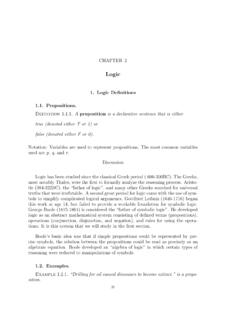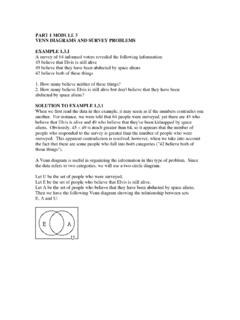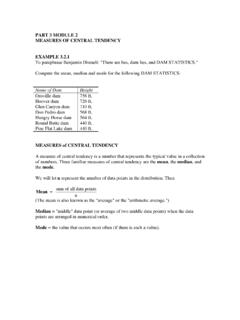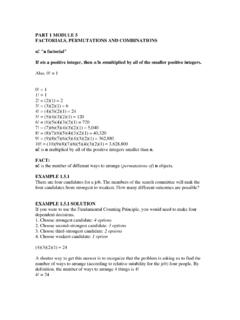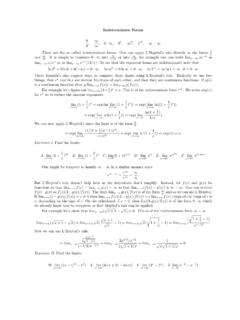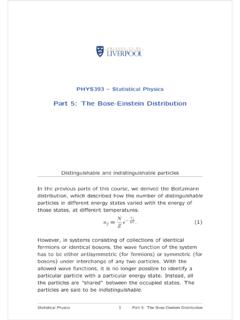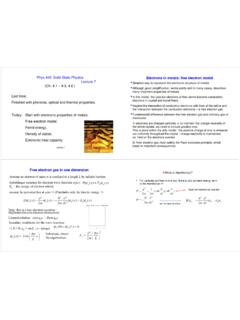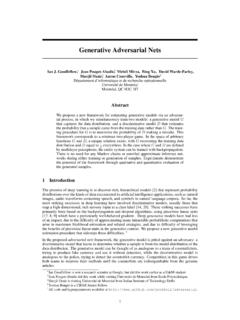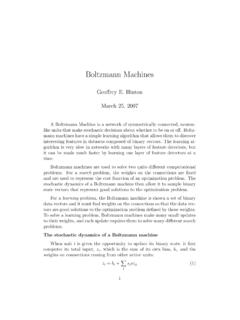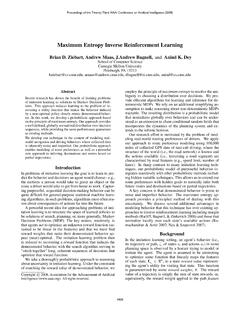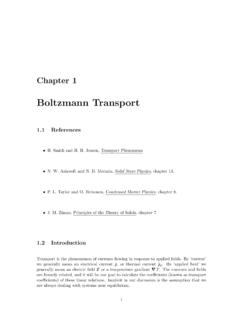Transcription of Poisson-Boltzmann - Florida State University
1 Consider the Lapla-cian operator(1) 2= 2 x2+ 2 y2+ 2 z2which is given in spherical coordinates by(2) 2=1r2 r(r2 r)+1r2sin (sin )+1r2sin2 2 2and in cylindrical coordinates by(3)1r r(r r)+1r2 2 2+ 2 is the electrostatic potential and is the chargedensity,Poisson s equationis(4) 2 = is the dielectric constant, taken to be 1 invacuo. Where there is no charge density, satisfiesthe Laplace electric field is given by(5)E= .and Poisson s equation becomes(6) E= simplest example is thepotential of a point charge at the origin with charge12q, theCoulomb potential,(7) =q4 (8)E=14 0r2 this case(9) 2 = q 0 0where is the Dirac delta function. This implies that is harmonic, 2 = 0, except at the other charge distributions in this medium ofconstant dielectric the potential can be computedby integration of the Coulomb potential.
2 If the chargedistribution is (r)dV(r), the solution to Poisson sequation (4) is given by(10) (r0) =14 0 (r)dV(r)|r0 r|.where the integral is over all space. The integralreduces to a surface or path integral if the chargedistribution is on a surface or a potential for some charge distributions iseasy to find by Stokes theorem. For example, ifa total chargeqis evenly distributed on a spherecentered at the origin the potential is seen to be thesame as the Coulomb potential outside the sphere,and zero inside the Poisson-Boltzmannequation arises because in some cases the charge den-sity depends on the potential . This makes (4)harder to solve since is on both sides of the equa-tion.
3 The Poisson-Boltzmann equation is often ap-plied to salts, since both positive and negative arepresent in in concentrations that vary with the relationship of concentration of charge to po-tential is given by statistical mechanics. By the Boltz-mann law, the probability of a particle having energyEis proportional toe E/kTwhereTis the temper-ature andkis boltzmann s constant. An ion of va-lencezin a field has electric potential energyze whereeis the elementary charge of a single boltzmann we can write the concentration as(11)c=c0e ze constantc0is interpreted as the bulk concentra-tion. The charge density from this ion is FcwhereF = Neis the Faraday the presence of many ions indexed byi, withvalencesziand concentrationsciwe have(12) = F izici= F izici0e zie make the assumption that the ion concentrationare independent.
4 Substituting (12) in (4) gives thePoisson- boltzmann Poisson-Boltzmann equation is a non-linearpartial differential equation. It can be simplified un-der the assumption thate /kTis very small andsoe e /kTis approximately equal to 1 e is sometimes called the Debye-H uckel approx-imation and the resulting Poisson-Boltzmann equa-tion is called the linear Poisson-Boltzmann and counter Poisson-Boltzmannequation is usually applied to a 1:1 salt solution wherethere are cations of valencezwith a counter ion of va-lence z. In this case the linear Poisson-Boltzmannequation becomes(13) 2 = 2 where(14) 2=2z2eFc0kT quantity 1/ is called theDebye length. Thisequation can be applied in the following two situa-tions(1) There is a central ion at the origin and the fieldhas spherical symmetry.
5 This is called Debye-H uckel theory.(2) The ions are on one side of a charged symmetry, Debye-H uckel case (1) above, if the central ion of chargeqis at5the origin, the potential depends only onrin spheri-cal coordinates. The linear Poisson-Boltzmann equa-tion becomes(15)1r2 r(r2 r)= 2 .and this has a solution of the form(16) =Ae rrfor some are two cases based on different boundaryconditions:(1) 2 =q 0/ 0.(2) There is a central ion of chargeqat the originand a sphere of radiusafree of the salt (1)TakeA=q/ 0and (16) approaches theCoulomb potential asr (2)Use a potential of the type(17) int=Cr+Dinside the sphere and of type (16),(18) ext=Ae rroutside the sphere. The electric field is given by(19)Eint=Cr2 r(20)Eext=Ae rr2(1 + r) the flux over the sphere in terms of the totalcharge on the central ion and using Gauss Theoremgives(21)4 Ae a(1 + a) =q 0and we can solve forA.
6 Assuming that the potentialand the electric field are continuous on the surface ofthe sphere gives two equations inCandDto solvefor the get finallyA=qexp( a)4 0(1 + a)(22)C=q4 0D= q 4 0(1 + a).The potential on the interior is(23) int(r) =q4 0(1r 1 + a).The potential on the boundary of the sphere is(24) ext(a) = int(a) =q4 0a(1 + a).The same analysis can be applied to find extifall of the charge is equally distributed over a spherea sphere of radiusR < a. If the smaller sphereis thought of as a protein (or amino acid) with allcharged residues evenly distributed on the surface,this becomes the basis of theLinderstr m-Lang model7for the charge on a protein. The distribution ofcharge over the surface allows us to assume spheri-cal symmetric and the analysis is the same as charge on the surface of the protein is(25) int(R) =q4 0[1R 1 + a]where is the dielectric constant of water.
7 This ex-pression can be used to find the work to bring acharge to the surface of the the charges sum to zero, for example in the case ofa polar group, then the above analysis will not workand the position of the charges within the proteinmust be taken into account. The Tanford-Kirkwoodtheory, which we discuss below, does take into ac-count the geometry of the charge the plane isx= 0,The potential depends only on the distancerfromthe plane and the linearized Poisson-Boltzmann be-comes(26)d2 dr2= 2 with solution(27) = 0e rand the potential decays this case the Poisson-Boltzmann equation canalso be solved analytically without the Debye-H uckel8approximation. Using (12) the equation is(28)d2 dr2=2 Fzc0 0sinh(ze /kT).
8 Replacing rbyxandze /kTbyy, get thereducedPoisson- boltzmann equation(29)d2ydx2= thatxandyare dimensionless in the reducedequation. It can be checked that a solution is(30)y= 2 log[1 e x1 + e x]where(31) =ey0/2 1ey0/2+ 1give the proper initial condition. The solution (30)is approximated by (27). useful way to get one harmonicfunction from another is inversion. The mapr r/r2is inversion in the unit sphere. It leaves the spherefixed and interchanges 0 and .Ifg(r) =r 1f(r/r2), we see from (2) that(32) 2g(r) =r 5 2f(r/r2).Iffsatisfies the Laplace equation 2f= 0 (fisharmonic) thengdoes sayfis a homogeneous polynomial of degreenif all the terms have total degreen. For such apolynomial we havef(tr) =tnf(r).
9 For any real numbert. By (32), iffis a harmonicand homogenous polynomial of degreentheng(r) =r 2n 1f(r) is harmonic and homogeneous of degree (n+ 1). potential function for a collec-tion of point charges can be obtained by adding thefunctions for the individual charges. If the chargesareqiat the pointsrithen the potential function is(33) (r) = iqi4 0|r ri|.A dipole is a configuration consisting of a positiveand a negative charge of equal magnitude. If thereare chargesqatr2and qatr1, the potential is(34) (r) =q4 0(1|r r2| 1|r r1|).For studying the potential of a dipole, it is usefulto have the Taylor expansion(35)1 1 + 2 2x = k kPk(x)10wherePkare the Laguerre polynomialsP0(x) = 1(36)P1(x) =xP2(x) =12(3x2 1)P3(x) =12(5x2 3x).
10 We have(37)1|r r1|=1r 1 + 2 2 cos where =r1/rand cos = r r1is the cosine ofthe angle between the vectorsrandr1. The seriesconverges for| |< (35) we get forrlarge,(38)1|r r1|=1r k(r1r)kPk(cos ).Using (38) the dipole potential (34) can be approxi-mated forrlarge by just the one term(39) (r) 14 0 rr2 q(r2 r1) =14 0 rr2 DwhereD=q(r2 r1) is called the dipole vector. Themagnitude of is of order 1 (39) the electric field for a dipole can also beapproximated(40)E= 14 01r3[3( r D) r D].11 The magnitude is of order 1 charge a number ofpoint chargesqjat pointsrjthe potential is thesum of the Coulomb potentials,(41) (r) = jqj|rj r|.Similarly, for a continuous charge distribution ,(42) (r) = (r1)|r1 r| (38) can be expanded in terms of Legendrepolynomials(43) (r) = n=0r n 1[ rn1Pn( r1 r)dr1]forroutside a sphere about the origin containing allof the charge(44) (r) = n=0rn[ r n 11Pn( r1 r)dr1]forrinside a sphere about the origin containing noneof the charge.
